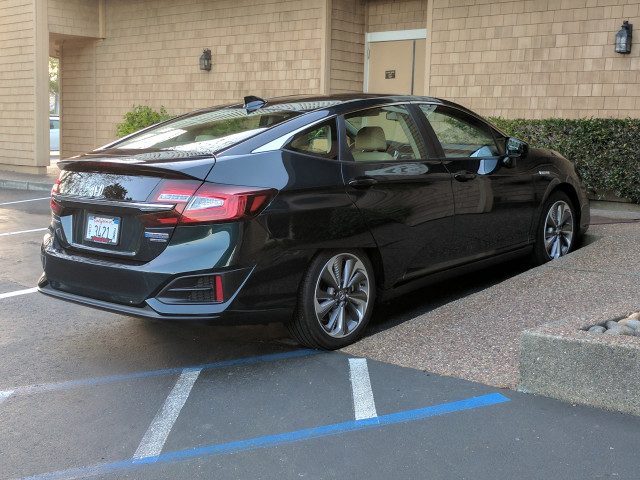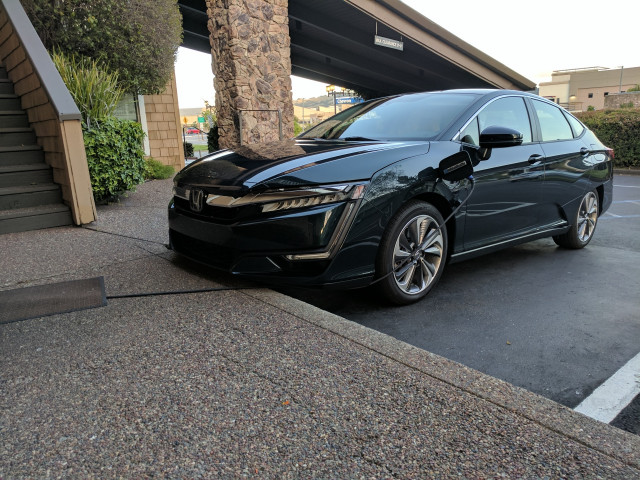2018 Honda Clarity PHEV revisited: is this the car Bill Clinton wanted built?
With new stewardship comes new perspective—sometimes on old things.
Here at Green Car Reports, we have driven the 2018 Honda Clarity Plug-in Hybrid a couple of times. New reviewers sometimes bring new context and background to subjects we've covered before. And that's the case with the Clarity PHEV, which we think deserves a little more attention than it's been getting in general.
Driving a Clarity PHEV in and around San Francisco for four days earlier this month brought this reviewer full circle to when I started writing about cars and began this journey of understanding how to make cars cleaner and less burdensome on our natural resources.
It was 1997, and I was riding in the back of a then-current ovoid Ford Taurus as a reporter, traipsing from Detroit to Washington, DC, with some students trying to make a point. The car was part of the FutureCar competition, a sister program to the Partnership for a New Generation of Vehicles (PNGV), a $2 billion program started by President Bill Clinton in 1993 to develop mid-size family sedans that could deliver 80 mpg. (In those days many mid-size sedans barely eked out 20 mpg.)
Each of the Detroit Three were tasked with producing a prototype sedan by 2000 before the program was scrapped under President George W. Bush. All three built prototype hybrids, two of which ran on diesel power.
The goals for the parallel, student-run FutureCar program were more modest—60 mpg—but the cars were much more ambitious. It was the first time I had heard of a hybrid, much less one that plugged in. Yet here I was, riding in a Taurus with tacked-on nose and tail cones, and powered by a 600 cc Yamaha motorcycle engine that mainly provided highway power. Around town it was propelled by a big nickel battery that sat in the trunk. (Nickel was all the rage in those days. Most teams, running lead-acid batteries, some of them spiral-wound, coveted the teams with enough sponsorship money to afford nickel.) If I recall correctly, the battery had a range of something like 10 miles.
The car could run on battery, gas, or both, much as we've become accustomed to in today's hybrids, except that the driver controlled a switch to govern what ran when.
Andy Frank, an engineering professor at the University of California, Davis, was the faculty adviser for the school's team who later became known as the father of the plug-in hybrid. He explained to me at one of the pit stops that his goal was to eliminate from the gas drivetrain any weight that was added in batteries or the electric motor. That car got more than 60 mpg on its 7-gallon gasoline tank before it flamed out climbing the Alleghenys on the Pennsylvania Turnpike.
I then had a chance to ride in two other cars, a Chevrolet Lumina from the University of West Virginia with a series-hybrid powertrain and a 4-cylinder engine running on CNG. Its primary drive came from the battery and the electric motor. The engine screamed along recharging the batteries at stop lights in Cleveland.
Finally, I rode across the finish line in one of the two cars that made it, a conventional hybrid built by the University of Wisconsin, based on a Dodge Intrepid running on ethanol.
Driving the 2018 Honda Clarity PHEV reminded me of nothing so much as the ultimate refinement of those cars, especially that Taurus from UC Davis.
The 2018 Clarity PHEV runs Honda's two-motor hybrid system, which delivers power to the wheels primarily from the electric motor. The gas engine is mainly a generator to provide electricity for the motor, using a buffer of energy in the batteries once the charge is depleted. A simple transmission clutches in the engine when rpm allows on the highway.
With 48 mostly all-electric miles, the Clarity PHEV is rated at 110 MPGe on the EPA's 50-mile test cycle. We drove two days and used hardly any gas. The car remained smooth and quiet the whole weekend.
Occasionally, if you press the accelerator hard, the Clarity PHEV will start its 1.5-liter gas engine for maximum acceleration or when climbing a steep grade at speed on the highway, even with some electric miles left in the battery. It just makes sense—those are the conditions when the gas engine works best and you'd be burning batteries down fast otherwise. Once it starts, the engine keeps running until it's warm to comply with emissions regulations.
On the highway, it's hard to even hear if the engine is running. Around town, where the Clarity PHEV acts as a series hybrid if the battery isn't charged, it can sound a little like that Chevy Lumina from the University of West Virginia.
We climbed some steep grades up and down California's Coastal Range from Mill Valley to Muir Woods, twice, without making much of a dent in the car's battery range.



Email This Page